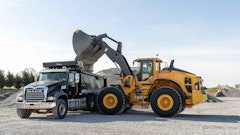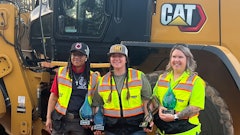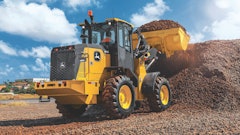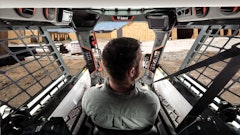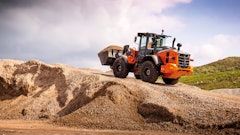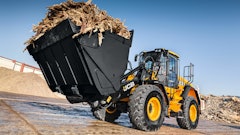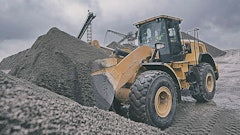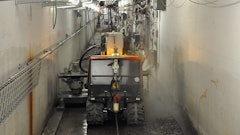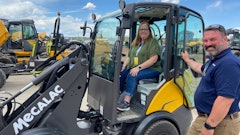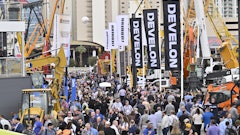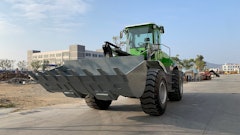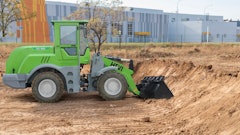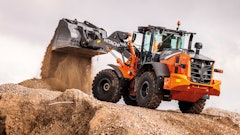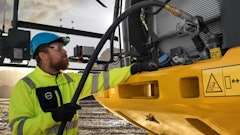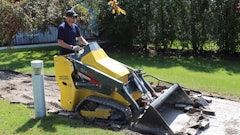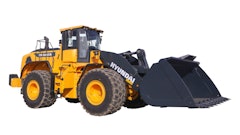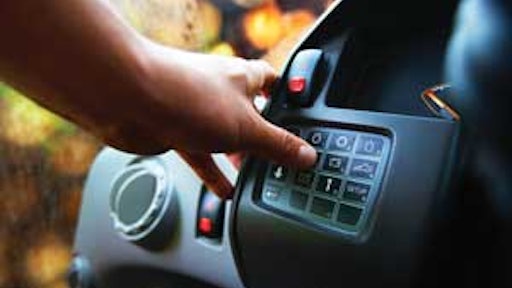
"The cost of off-highway electronics has come down over the last decade as the capability has increased," says Jahmy Hindman, wheel loader product marketing manager, Deere & Company. "These advances have allowed companies to adopt technologies like onboard payload weighing, automatic ride control, keyless start, auto-idle and auto-shutdown, tire pressure monitoring and programmable return to dig."
For instance, auto-idle allows the engine to idle at ultra-low speeds when the wheel loader is not being used. "This is controlled electronically in Deere wheel loaders and reduces idle fuel consumption by as much as 25%," says Hindman. "In addition, we have implemented an electronically controlled auto-shutdown feature. It turns the engine off after an operator-specified amount of low-idle time has elapsed... Of course, for those colder climates that require the engine to run for heat generation, this option can be turned off, as well."
The integration of cutting edge electronics into wheel loaders has always been a top priority, asserts Nick Rogers, product specialist, Liebherr Construction Equipment Co. "We recognize that through multiple types of hardware and software, we are able to produce a machine that will be more efficient, easier to diagnose, faster to set or change parameters, and exceptional to operate," he states. "Liebherr has been able to produce a machine with features that are either electronic or electronically actuated to enhance the productivity of the machine, as well as the comfort, safety and ease of operation for the operator."
Productivity is further enhanced by giving the operator more control. "The operator can set parameters, adjust settings, recognize any operating issues and easily operate the multi-function joystick, which is electronic-over-hydraulic controlled," says Rogers.
Control at your fingertips
Electronics often actuate and monitor return-to-dig, return-to-carry, slip control and automatic gear kickdown options. "The boom suspension (or ride control) is the option that has yielded the most production gains in many applications," says Mike Dayton, Volvo Construction. "It reduces spillage on load and carry operations, and allows the operator to travel at high speeds while remaining in control and operating safely."
Some electronic systems also allow the operator to customize the responsiveness of the controls. For example, Doug Phillips, Volvo Construction, notes, "We can speed up or slow down the controls with a simple V-Cads programming tool."
Liebherr recently integrated a touch screen multi-use display in its L550 to L586 large-sized wheel loaders. According to Rogers, this electronic touch screen display allows the operator to set or change machine operation settings, check temperatures, levels and pressures during operation and control the climate in the operator's station, along with many other features.
Kawasaki's onboard monitor allows the operator to custom tailor machine operation, as well. "The operator or technician can make adjustments to the ride control system, the stick steering system or the brake de-clutch system through the monitor," says Gary Bell, vice president, general manager, Kawasaki Construction Machinery. "You can modify the machine's characteristics to suit the operator."
Onboard payload systems, such as those found on John Deere loaders, further empower the operator. "In truck loading applications, an onboard payload scale improves productivity by making sure the truck is loaded to the correct weight the first time," says Hindman. "This avoids having the truck come back from the weigh bridge if it is loaded too heavy per state DOT regulations. This can improve operational load-out efficiency by 5% to 10%, depending upon the operation."
Steering has also seen dramatic improvements via electronics technology. "Liebherr offers a 2-in-1 steering system that creates a smaller ratio of rotations on the steering wheel for better operator control and comfort. When equipped on a loader, the 2-in-1 steering can be engaged via the electronic keypad panel or the touch screen display in the cab," Rogers points out.
On smaller wheel loaders, electrohydraulics enable the use of both a steering wheel and joystick steering. "You retain the steering wheel along with the stick steer," says Bell. "It reduces operator fatigue and increases productivity considerably. We have measured as much as 20% higher productivity with a joystick and stick steering over a steering wheel. If you are V loading or doing a lot of maneuvering, the stick steer is by far the best way to go."
Efficient powertrain solutions
"The powertrain is the main area that people use electronics as compared to previous designs," says Bell. "The shifting of the transmission is easier because it is not going through a mechanical device, but an electronic servo device." This results in lower lever effort and increased precision of the controls.
Electronics have been key to powertrain integration. "The powertrain in the Liebherr wheel loaders has been fully integrated with electronic technology that sends and receives operational data, diagnostic information and regulatory measurements to ensure the machine is running at the most efficient levels at all times," Rogers states.
"The largest performance gains attributed to electronics technology has come in the powertrain area," adds Hindman. "The two biggest benefits have likely been in lockup clutch control for our new lockup torque converter transmissions, and fuel injection optimization to provide excellent torque rise while still falling into emission compliance.
Customers can expect 10% to 15% better fuel economy with the lockup torque converter transmission over a conventional torque converter in applications that include ramp climbing or significant stockpiling."
Electronic Control Units (ECUs) on the engine and transmission constantly monitor and control key performance parameters. "The largest performance gains have been made in the ability to more accurately match the engine performance requirements with the drivetrain requirements to effectively complete the tasks required by the equipment," says Dayton.
Improved maintenance and tracking
Electronics technology is necessary to achieve the more precise combustion that is required for emissions controls.
"Along with that comes a fairly sophisticated diagnostic capability of the engine," says Bell. "Now you can troubleshoot problems on the engine easier due to the electronics. On our particular transmission, we also have electronic diagnostics so you can diagnose fault codes through the electronic monitor that is on board the machine."
Fault codes and data from onboard sensors is stored by the onboard monitor. This data can then be transmitted to a remote location via a telemetric system for analysis. "We call our system K-Link," says Bell.
Other manufacturers offer sophisticated telemetry systems, as well. Volvo's CareTrack system can be set to monitor critical machine functions and send out alerts for service intervals. "This system assures the machine is serviced at the determined times," says Phillips.
"If the key is on," he continues, "we can pull a Matris download from the machine to read fault codes, track location, see if the machine settings are correct for operation, keep a constant reading on pressures, temperatures and operation errors such as high-speed shifting." The system also provides tracking via GPS, along with geofencing and operation time settings, for theft prevention.
"As of January 2010, the CareTrack system will be a standard feature on Volvo wheel loaders and it will include three years of free service," says Phillips.
Deere's JDLink telematics system is available on all the company's wheel loaders and is standard on the 624K through 844K models. The system monitors the information on the loader's communication bus and stores the data on the machine.
"Once a day (or on demand), this data is uploaded to a central server where it is visible to the owner or equipment manager," says Hindman. "With JDLink, a service schedule can be set up that will warn the owner or equipment manager when a vehicle is close to needing periodic maintenance. This system also allows for geofencing of the machine, which warns the owner or equipment manager when the machine leaves a defined geographic location.
"The primary benefit is always knowing where all pieces of your fleet are geographically," Hindman continues. "This sounds simple, but until telematic systems became available, this was incredibly difficult to do accurately. The secondary benefit is knowing how many hours are on individual pieces of equipment. JDLink takes the guesswork out of some aspects of fleet management."







